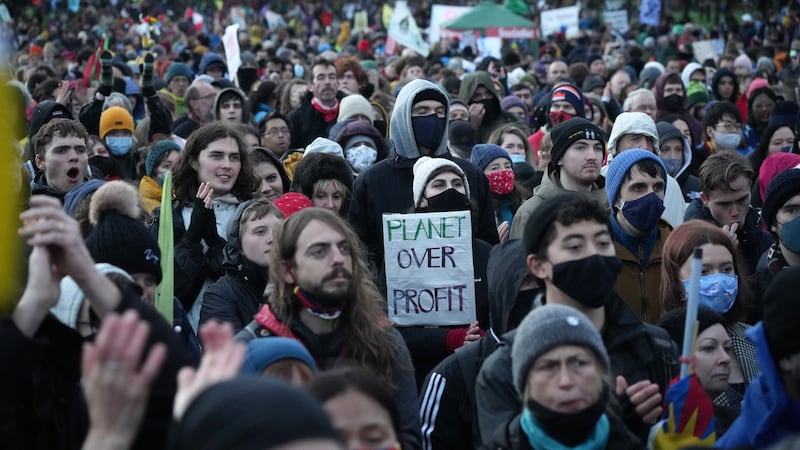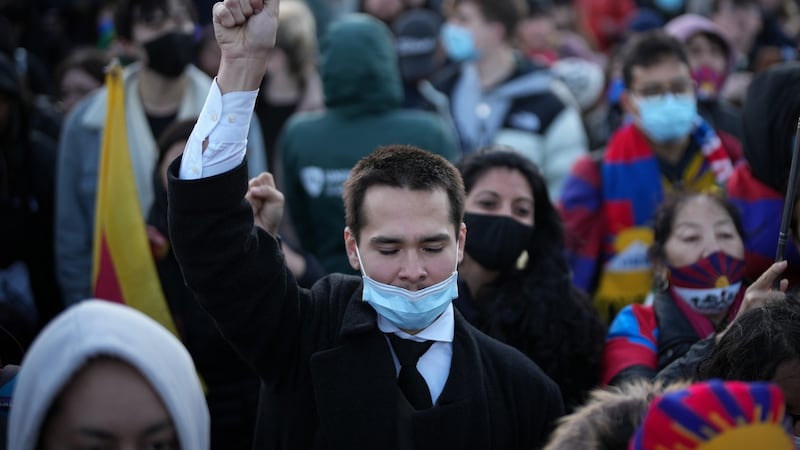At least 100,000 people are gathered in Kelvingrove Park, Glasgow in the torrential rain. They’re marching from here eastward to Glasgow Green for the Global Day of Action for Climate Justice.
Jen Morris from the Young Christian Climate Network has helped push a boat on wheels all the way from Cornwall. The vessel is called the Pilgrim” and has a sail – but it’s hull is a wicker coffin. “It signifies that while we’re all in the same storm, we’re not all in the same boat.”
Consuela Rosa, an artist, and Ellen Naughton, a Sligo-born occupational therapist, have two beautifully painted signs. Naughton spent the week making banners with the patients she works with. “We’re hoping that protests like this will hold politicians to account,” says Naughton. “We never thought to waterproof proof the signs though.”
Rosa says “they’re quite soggy”, feeling the paper. Like the Fridays for Future protest the day before, indigenous activists and those from the frontline of the climate crisis lead the march. A huge group of people is gathered holding hands in a big ring around some of them as they address the crowd before the marches even start. Nearby, a phalanx of Young Communists with red flags, red smoke flares, red face masks and black clothing come marching through with a big banner.
They have several chants that run from the innocuous, “When the reds go marching in!” to the more politically suspect, “Ho-ho, Ho Chi Minh, Che Guevara and Stal-in!” One of the communists says “guys remember to turn face ID off on your phone”. Later I learn the police kettled them away from the main protest for several hours. Earlier a number of scientists affiliated with Extinction Rebellion were arrested after chaining themselves together across George V Bridge.
Adults and teenagers
On the march here things generally have a lighter atmosphere. People dance to the kilted brass and drum players of Samba la Bamba. Wellwishers hang out of windows along the route holding signs and cheering. There are rain-soaked dogs and children in pushchairs and older people with walking sticks. The Woodcraft Folk, which is an all-ages group that focuses on education for social change, has created a big caterpillar from recycled tarpaulin. It’s being manoeuvred by a procession of adults and teenagers.
“We were going to have butterflies coming out of a caterpillar with a chrysalis on top of it,” says a man called Neil. They didn’t quite manage to do that. “We have the chrysalis but no butterflies to come out of it.” Why a caterpillar? “It’s radical change, isn’t it?”
Eight-year-old Harris Cunningham, here with his younger siblings and ecologically concerned parents (they have an organic farm), has a pretty good understand of the situation. “We’re here to tell the presidents that we can’t find new planets so we want to save this one. Because if they don’t, it’s not fair to young people.”
John Kingston is holding a stick on which is stapled old bags, plastic ties and broken plugs. He works in a social enterprise called Glasgow Wood Recycling. He wanted to make a sign but he couldn’t think of anything to say. If he said what he felt, he says, “I wouldn’t be able to fit it all in. I was cleaning up at work and thought I could just use that rubbish. So it’s literal rubbish, it’s also the rubbish of the situation and the mental, internal rubbish you keep in your head because you can’t do anything.”


Paul Richards, an accountant, holds a sign that says, “So bad even accountants are here”. Climate change affects everyone not just your typical protesters, he says. What are his usual politics? “I heard a term the other day, ‘champagne socialist’, and thought that sounded like fun. Things aren’t black and white. This isn’t a left/right thing.” He’s in a minority here thinking that the issue is not a left/right thing. Many believe that life on the planet cannot be saved without completely restructuring society.
Sarah Gorton and Maya Gorton, both with Extinction Rebellion, are carrying large wooden eyes made by their artist friend Loo Ogden. The pupils on each can be moved with a lever at the back (like Action Man). “It’s to say to the politicians, ‘the world is watching you”, explains Sarah. “Our leaders are accountable to us.” Is she hopeful? “We don’t have any faith that they will make the right decision because you can’t make any right decisions for the planet that are compatible with economic growth. And they’re stuck in that system.”
The sun comes out for a while just as we arrive in Glasgow Green around three hours after setting out. I get some food from some kind Hare Krishnas who have set up to one side of the stage. A group called #corprat! are dressed in business suits and rat masks and engaging in absurdist agitprop. A woman walks around with a skeleton on her shoulders with a sign that says, “This is what 1.5 degrees looks like.”
What about Greta?
A woman tells me that Greta Thunberg has given up her speaking slot to make sure more activists from around the world get a chance to speak. It’s difficult to get close enough for me to hear anything. Everyone seems buoyed up despite, in many cases, freezing in rain-soaked clothes. A little earlier in the day I see a man with long white hair playing flute along to a sound system someone is pulling in on a cart. His name is Bob Parks. He’s a musician and artist and the BBC made a documentary about him a few years ago called That R&B Feeling.
“I love protests,” he says. “I was in CND back in the sixties, but this is far more important than just ban the bomb, it’s save life on Earth, period.” Is it important to protest like this? “It’s like the caterpillar going into a chrysalis, the immune system is stronger when it comes out as a butterfly. It’s a paradigm shift that we’ve got to have.”
This is my second caterpillar metaphor of the day and it makes me feel hopeful. Parks isn’t sure if he’s hopeful or not. “I’m a nihilist,” he says, “a moral relativist from the sixties. But my training in art school was not to have preconceived ideas. The role of the artist as defined by \[RG] Collingwood is to work to prevent the corruption of consciousness.”
He waves his arm across the protesters. “This is a cleansing voice. It’s the voice of truth and it has to be put out there.”












